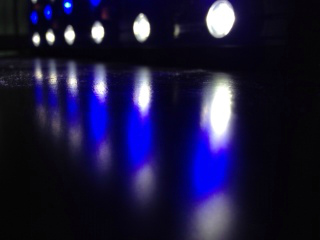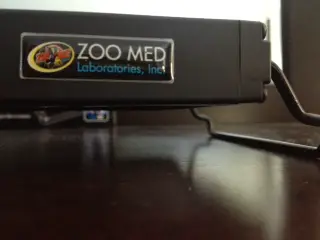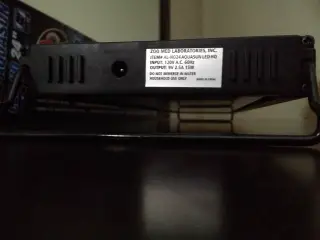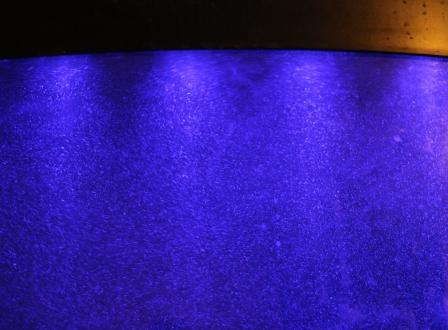ZOOMED Laboratories just added an LED light fixture to their line of aquarium lights–the AQUASUN(R) LED light fixture.
 The fixtures are equipped with high-output white and blue LED lights. The image below shows the white and blue lights on together–white and blue can be operated independently with different switches.
The fixtures are equipped with high-output white and blue LED lights. The image below shows the white and blue lights on together–white and blue can be operated independently with different switches.
The white lights sip a modest 1 watt of energy each and produce light at a temperature of 6000k. The blue LEDs consume only 500mW each and produce 465 nm blue light.
ZOOMED’s commanding claim on the box is that their High Output LEDs are 50% brighter than T5’s. I was surprised by this claim and actually sent a note to the manufacturer asking for them to explain this statistic.
The fixture boasts an aluminum housing, which is better for heat transfer than plastic housing. Better heat transfer, with LED lights, translates into longer life. The ZOOMED LEDs are rated for 20,000 hours, which is approximately 3-4 years, depeding on your lighting cycle.
I tried out the 24″ strip at home this week. There were 12 white LEDs and 6 blue LEDs

The fixture has a slender profile. The whole thing stands on are small wire legs which are adjustable–they slide out a few inches so you can adjust the length to the size you need to comfortably rest above your aquarium. If you don’t want the fixture to rest on your aquarium, the kit comes with cables for mounting.
The fixture has two light switches so that you can independently control the white and blue light switches.

Perhaps the biggest downside I see with this fixture is that while there are two switches–so that you can control the blue and white LEDs independently–they are both operated from a single power supply, so you have to turn the lights on and off manually.

Pros: The AQUASUN LED light fixture I tested consumed 15 watts and boasts a light output 50% greater than what would have been produced by T5s (according to the claim on the packaging. T5 fluorescents are already an energy efficient bulb–a 24-inch 2 bulb fixture would consume 48 watts (and produce 50% of the output). This 24-inch fixture (adjustable to 36 inches) would do well above a 20 gallon (high) aquarium or even possibly as large as a 40 gallon breeder (with the adjustable legs fully extended). Those tanks are generally 17 inches high–which would ensure the photosynthetic livestock are within the recommended 12-18 inch range (By the way, I found the dimensions to almost every aquarium size ever made on this site).
The 6,000 Kelvin color temperature is perfect for maximum growth due to photosynthesis, which should really maximize the growth per watt of electricity consumed.
The design is sleek and low profile, mounting just above the aquarium or it can be suspended above the tank using the included equipment.
Using the blue LED lights at night to simulate moonlight does create a dramatic effect on the aquarium. I have used other LED lights where the actual blue that is used seems harsh and artificial. The Blue LED with the AQUASUN light creates a deep-water, almost purple effect in my tank and really picks up the fluorescence in my corals.
Cons: While having blue and white LEDs wired on different switches allows for independent operation of the lights–I have personally switched over to using a timer to turn my lights on and off a long time ago–since the AQUASUN LED light fixture only has 1 plug, that effectively eliminates the use of the moonlight feature for me. The fixture will either be 100% on or off. If you don’t mind manually turning your aquarium lights on and off, then that won’t be a problem for you at all.
While I only tested the 24 inch light, I wonder if the larger lights (36 or 48 inch) are truly powerful enough to be used in reef tanks. In my 92-Gallon corner aquarium (not your average-sized or shaped aquarium), the light reached to the bottom of the tank, but it lit only the area directly under the light and was not especially bright at the bottom. With a longer strip (like the 36-inch fixture) I would expect a longer line of the aquarium lit, but probably comparable brightness at the bottom. I wonder if the larger tanks would be sufficiently bright to sustain reef photosynthesis (although test this, I suspect a single manifold would not be enough light for a deeper/larger tank). I plan to continue to test the light and see how it does at supporting photosynthesis at various depths.
Conclusion: The 24-inch AQUASUN LED light fixture, as tested, is a solid option for a nano reef aquarium (up to and including 20 Gallons and perhaps larger), a large refugium or a quarantine or hospital tank. Running at an energy sipping 15 watts, the AQUASUN LED Light fixture would cost about $11.50 to run for a year (electricity costs) compared with about $67 for a comparatively sized T5 fixture (cost of electricity and replacing bulbs once). In addition, the manufacturer boasts a claim that these lights are 50% brighter than a the light output from a comparatively sized T5 fixture. As an upgrade from your T5 fixture, I think it’s a solid choice–but if you’re looking for state-of-the-art LED with all the bells and whistles, there are other fixtures available out there with dimmer switches, iPhone apps and you-name-it gadgets. But I don’t think this light tries to be those things–I think it tries to be a good substitute for a T-5–and it is.

Disclosure: ZOOMED is an advertiser on this website and provided me with the light fixture to evaluate. The opinions expressed here are my own and are a representation of either my first-hand experience with the lights and the information (specifications like 20,000 hour rating and 50% brighter than T5 claim) provided by the manufacturer. I did not test these claims specifically–although I did inquire with ZOOMED about some of these claims for further clarification. All the photos here were taken by me.
Here are a few other resources you may want to check out:
I put together a quick tool (a spreadsheet, really) to help make the math easy to compare the costs of running an LED light with the costs of running a traditional light. Essentially, LED lights generally cost more money up-front, but they tend to pay for themselves when you look at energy cost savings and the cost savings from eliminating light bulb changes. You can access that tool free on Google Drive. If you want to read the post I wrote about the possible cost savings from switching to LEDs you can find that here.
If you want to embrace your inner-nerd and learn more about LED lights–check out this page
To read more about other saltwater aquarium equipment, check out this page
AQUASUN is a registered trademark of ZOOMED Laboratories, Inc.
Review written by Al Ulrich

Leave a Reply